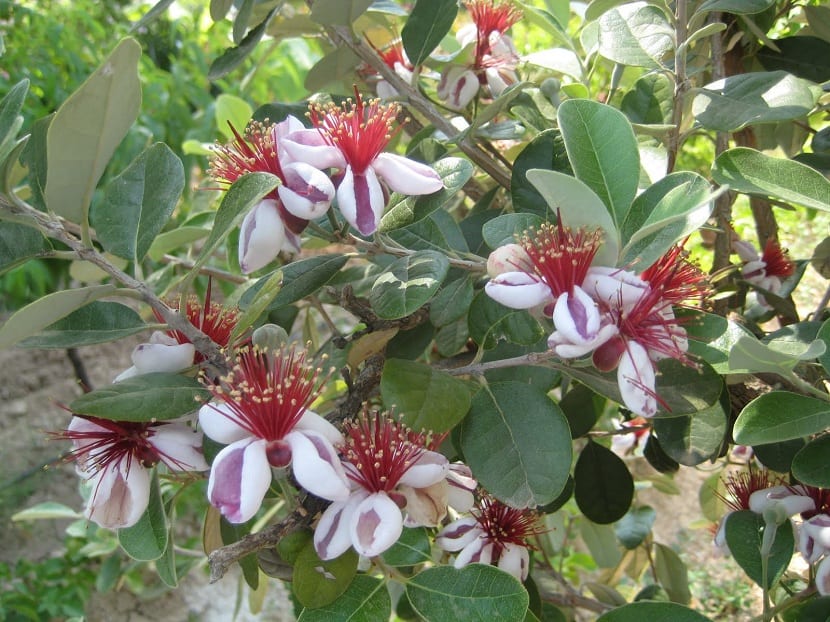
We traveled to Brazil to see in depth a fruit tree called feijoa. Its scientific name is acca sellowiana and it is also known by the Guayabo of Brazil. It is evergreen and belongs to the Myrtaceae family. It can be used as an ornamental shrub in many types of gardens.
In this post we are going to tell you everything about this fruit tree. Do you want to know more about it?
Generalities
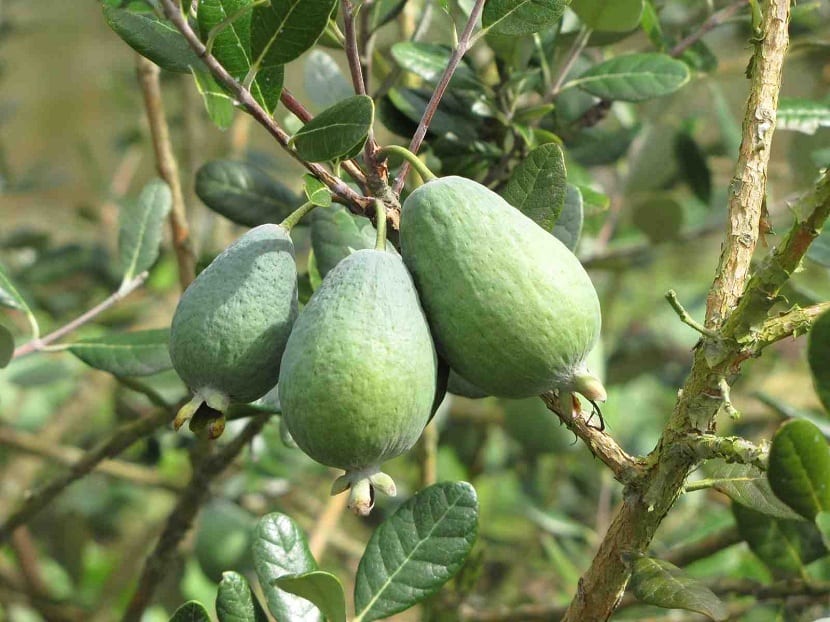
It has its origin in southern Brazil and northwestern Uruguay. Since then its cultivation has become commercial and has spread to many countries around the world. A few decades ago he arrived in Spain.
This shrub is well known for its beauty and can reach up to 7 meters in height. Its bark is rough and the color is dark gray. As for the leaves, they are elliptical in shape, leathery, with a bright color on the upper surface and whitish on the underside. The flowers are quite showy and pinkish-white in color. When the summer season arrives, its stamens are red.
The feijoa leaves us opaque green fruits and a rough appearance. They are assimilated to a pebble. They are the size of a hen and mature in the fall season. They stand out for the persistent aroma that reminds you something of pineapple. Its pulp is fleshy and yellowish-white in color. In the center is the gelatinous pulp with a bittersweet flavor.
This fruit is ideal for making compotes, jams and jellies. Their maturation is completely complete when a few days pass after being collected from the ground. This factor facilitates the transport and storage of the fruit without losing quality.
How feijoa is selected and stored
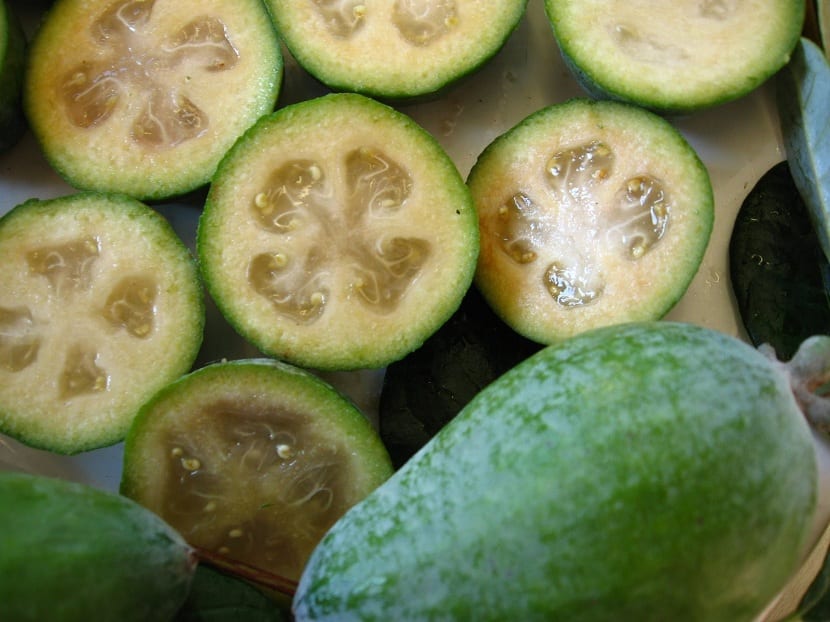
Ripe feijoas are those that have been in storage for a few days or have fallen on the ground. If the fruit yields quickly to a little pressure, it is fully ripe. Its pulp is shiny and gelatinous in appearance.
When you buy them you can keep them in the refrigerator in perfect condition for about two weeks. However, once the fruits are open, they should be consumed immediately. Its pulp is oxidized by the action of air and when peeling them we must put them under water so that it does not oxidize quickly. The thick petals of the flower are tasty and can be used in salads.
Properties of feijoa
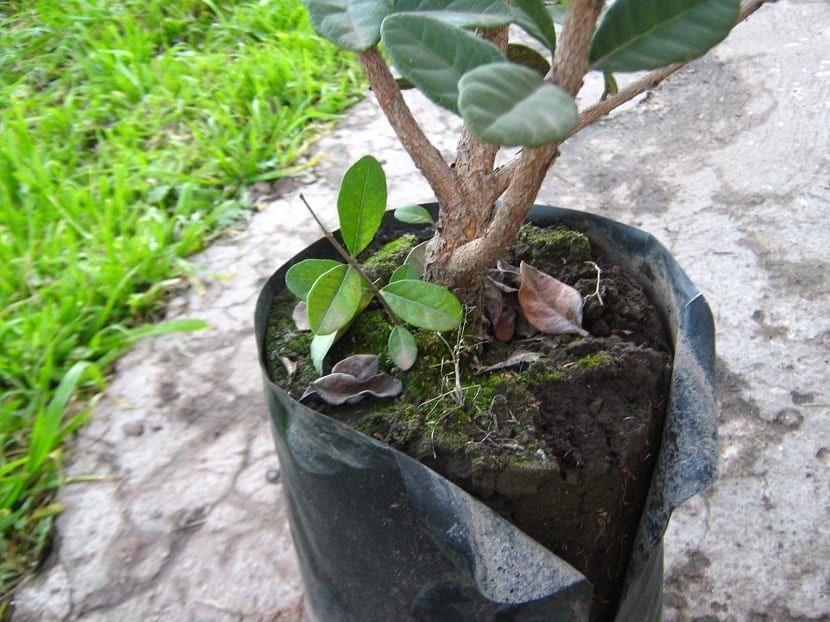
It is a fairly complete fruit that provides us with vitamins B1, B2, B3, B6, B9, and C. In addition, they provide valuable minerals such as calcium, magnesium, sodium, zinc, phosphorus and potassium.
Among the most important properties that it has we find:
- Thanks to its content in flavones and cytoquinones it has anticancer properties.
- It is beneficial for the thyroid, since it has iodine.
- It tones the body helping to combat fatigue, irritability and helps prevent depression.
- It is a good ally to combat cholesterol with its high pectin content.
- Eliminate free radicals with a high concentration of antioxidants.
- Increases the production of red blood cells, which helps fight anemia.
- It has antimicrobial and antifungal activity and is effective on Helicobacter pylori.
- Improves kidney functions.
- For the care of hair, skin, stabilize the normal sleep cycle and reduce stress, it is recommended to blend 4 feijoas. We add honey and mix with a gram of royal jelly. We can also add a teaspoon of bee pollen. It is taken during 30-day cycles, with a 15-day break.
Conditions of its growth
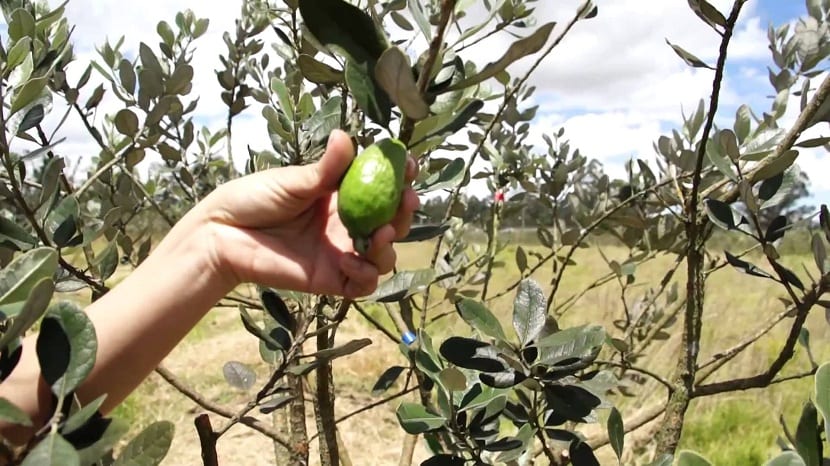
This shrub is probably one of the most robust of the subtropical fruits. When it comes to growing them, you just have to keep a few things in mind. We have the advantage that it is a shrub with great resistance to drought and tolerates frosts down to minus 9 degrees.
Keep in mind that the soil where we grow it has to have good drainage, be rich in organic matter and have many hours of sun. It is highly recommended to protect them from the winds as they can damage their leaves. Although it is well resistant to droughts, it is always good to add some humidity in the summer months. It is also recommended that the soil where it is grown is padded.
It can be grown from seed, but it does not reproduce true to type. Germination takes place in about three weeks. Substrates for the seeds must be fresh and clean so that rotting of the seedlings is avoided. Once planted, they can produce the first fruits between 3 and 5 years from sowing.
Reproduction
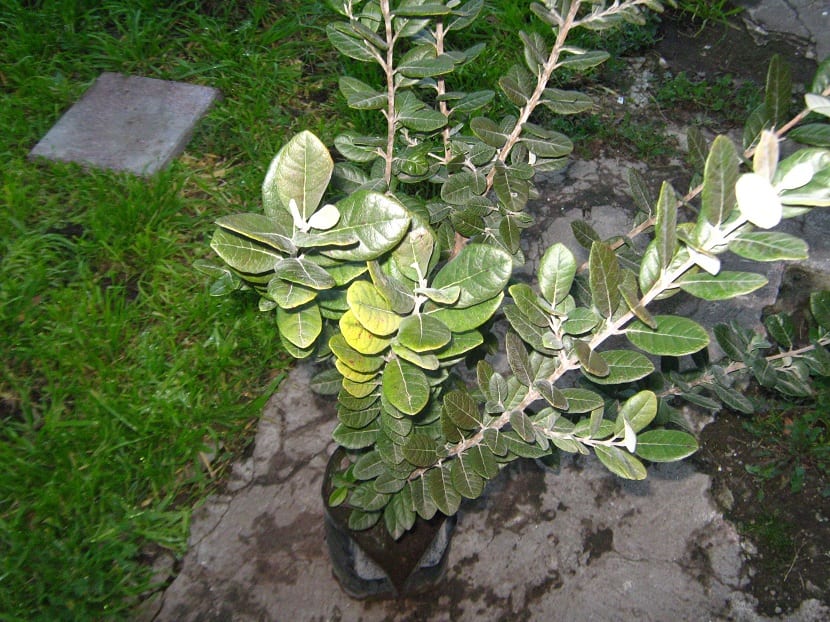
To reproduce this plant vegetatively it can be done with various means. If it is done vegetatively, the terrestrial layering method will have to be used. It is a method that uses well the rooting that occurs after about 6 months.
Cuttings (cuttings) can be taken from young wood from branch tips or secondary stems with a stub in summer. They will root in 1 to 2 months with the lower heat and a rooting hormone agent, given a humid environment.
Once we decide to plant, we must respect a space of about 3 to 5 meters between each one. This helps the plants not to compete for food and water. Otherwise, the roots may become clogged with each other. For each hectare and following these steps, we can fit about 500 specimens.
We must not fertilize it with an excessive amount of nitrogen fertilizer, since it can cause too large a growth.
Irrigation, pests and diseases
As we have said before, feijoa is drought tolerant. However, if it lacks water it will cause the fruit to fall in order to better organize the internal water and not die. In the periods in which the plant blooms and develops the fruits it is the moment in which it is necessary to watch more the irrigation. Padding is a good idea to protect it from wind and moisture loss. Can be formed grass, grass clippings, etc.
As for pests and diseases, feijoa is quite resistant. It is occasionally attacked by some insects, as well as fruit flies, but it is not difficult to treat.
I hope that with this information you can enjoy feijoa.
Excellent article, thanks for the contribution, greetings from Chile.
I have my Feijoa with the first flowers, very happy!
That's great! Let's enjoy them then 🙂
In Colombia it is also cultivated. Especially in Boyacá, there is a large local industry from which families support themselves. With it, in addition to what is exposed in the article, ice creams, candies, sabajón (drink) and a sandwich are made, which tourists buy. Thanks for the article, it helped me to guide me where to plant my bean tree.
Thanks to you for the information provided, Ari 🙂
I have several feijoa bushes in the garden and they give excellent flower and fruit. Here, in the Basque Country, it is little or nothing known. At home we eat it raw, peel it and cut it into slices, excellent. Above, if it has those properties that they say, all the better.
I gift to my friends and, at this time, they remember to ask me about them. They seem to like it.
They do not fail, they always bear fruit and are abundant.
Hi Look.
Thanks for your comment. Without a doubt, feijoa is a very grateful plant, and useful 🙂
Regards!
Hi, I just bought one but I live in the south of Ourense, it's almost 1000 meters away and it's windy. Can it be planted here? Thanks
Hello Pili.
It can hold up to -9ºC, so if it's not too cold in your area, it can happen.
A greeting.
I really liked your article. Very complete, clear and, above all, concise.
I just got to know this fruit just two months ago. They gave me a few feijoas and, honestly, I loved them.
3 weeks ago, I bought a bush in Portugal, where they are best known. The saleswoman told me that next year it will bear fruit.
The plant is about 60 cm high and is already withstanding the inclement weather in a village in Pontevedra.
Since you say that new trees can be created from a new branch, in spring I will try to do it.
Thank you very much for your contribution!
Thank you. Surely you will enjoy feijoas for years 🙂
Just one detail: being young, I would recommend waiting for them to grow a little more before taking cuttings. This would give them time to finish getting used to their new home, and your care.
Regards!
Is it true that I know if only one tree is planted, it will not bear fruit? Should a minimum of 2 be sown? What distance should there be between them?
Hi John.
Feijoa flowers are hermaphroditic, so it is not necessary to have two specimens to get fruits.
Anyway, if you want to have two, I recommend leaving at least 1 meter of separation between them.
Regards!
I have this little tree, for 7 years and about 2,5m. height approx. and that it has never given us fruit but many flowers. It was a gift and we were told that it was a bush and did not grow much. It was planted in the ground, in a place where, to this day, it has been boxed in, tripping over two other trees that it has on both sides. We have land and we want to transplant it to a place with more space. Can it be transplanted? What is the best time? What advice can you give me for this operation? Pre-coastal area of Barcelona.
Hi Xavi.
Certainly, it would be advisable to transplant it to an area where it could grow more.
The best time is late winter. Make trenches about 40cm deep and at a distance of 40cm from the trunk, and then you can easily extract it with a strip (it is a kind of shovel, but with a rectangular and straight blade). If you don't have a blade, a saw will also work for you, although the work will be much more arduous.
With a hoe you could try, but only if you try to make the blade impact horizontally, so as not to damage the roots as much as possible.
Before doing anything, it is advisable to have the planting hole prepared, so that as soon as the plant is removed from the ground it is planted in its new place quickly.
Greetings.
Do you have any valid or sustainable knowledge about feijoa evapotranspiration?